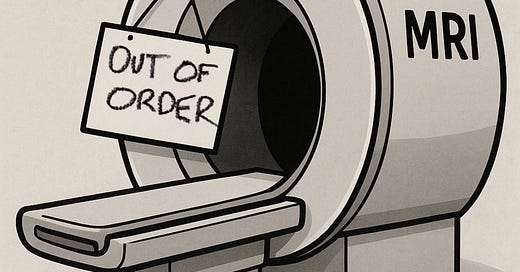Need an MRI? Sucks to be you.
Foreign policy limits healthcare, just as confidence limits reason.
If you need an MRI in the US, you may not be able to get one because of an ongoing trade war.
On April 4, China restricted the export of seven rare earth metals. A great deal of fuss was made of the impact this will have on consumer electronics and defense contractors, but next to nothing has been said about how this will affect the 40 million Americans who need medical imaging each year -half of whom need gadolinium (Gd) as a contrast agent, which is one of the seven restricted exports.
No big deal, the US can just get it from some other country, right?
Maybe, but certainly not in time to avoid a shortage if restrictions persist. China provides 97% of the world’s raw gadolinium oxide, and it commands over 80% of the world’s refining capacity. Even if your contrast reads that it was made in the US, it was only modified slightly and packaged there, and cool packaging isn’t going to get you the material you need for a scan.
The US has exactly zero refining infrastructure to convert raw materials all the way into medical grade contrast. Heavy-rare-earth separation at scale (which includes Gd purification) is almost an entirely Chinese operation. Vietnam, Brazil, India, and Australia have respectable deposits of gadolinium ore, but their mines already feed Chinese refineries, so trading with a different nation isn’t a feasible strategy to workaround China.
No big deal, the US can just mine its own, right?
No, not in any way that would matter in the next decade. The U.S. is currently 100% dependent on foreign sources of gadolinium. It has almost no significant mining capacity and precious few deposits to mine in the first place.
While the US does have significant rare-earth deposits, they favor light-rare-earths (which contain no Gd). Large, easily accessible heavy-rare-earth deposits are far more scarce. To give you an idea of how far behind we are, the US has just one active rare-earth mine -compared to 72 active domestic gold mines (and I have heard that gold was kind of rare). Mining and refining operations take a little more planning and labor than erecting a Chick-fil-A, and yet those don’t go up overnight either.
No big deal, my radiologist can just get an MRI without contrast, right?
Yes, but only half of the time. If you are part of the half who needs contrast for their scan, and you do NOT get it, you will miss a few small diagnoses like:
Primary tumors, metastases, inflammatory conditions, severe infections, active multiple sclerosis lesions, various sorts of cardiac pathology, and a host of vascular abnormalities including but not limited to aneurysms, and arteriovenous malformations. So… just little things that frequently lead to really bad things.
Is the future as bright as the contrast that Gd provides for MRI’s?
My goodness, no. In order to maintain a steady supply of foreign Gd, diplomacy is a must, because we don’t have any immediately available domestic reserves or trading partners who can replace China. Diplomacy goes a long way in determining if your child has a benign or malignant tumor, which is going to be a lot trickier without contrast. I mean… YOU try to differentiate an atypical teratoid rhabdoid tumor from a pilocytic astrocytoma without gadolinium. Its hard. Much harder than maintaining previously stable trade relationships.
If restrictions are severe and prolonged, look into domestic companies who produce iron oxide nanoparticles, such as ferumoxytol. This is relatively cheap, commercially available and has been used off-label as an MRI contrast agent. I strongly suspect that GD-alternatives will be a hot topic of near-future biomedical research (and stock investment), given the state of current geopolitical affairs. It never hurts to be prepared.
Love letters to absurdity:
I posted a shorter version of what you just read above on LinkedIn. It was mostly well-received, and I felt it was a minimally-political opinion piece discussing the real-world ramifications of politics on medicine -specifically as they pertain to contrast-MRI imaging. Its not exactly a platform issue for any political party.
I was gifted some amusing responses from casual contrarians. They are not skeptics because skepticism requires reason, knowledge, and acceptance of verifiable evidence -which is not the same as stating a contrary opinion with and abundance of confidence and an absence of proof.
There were more of these than I could individually respond to, so I broke them down to respond en masse, and by flavor:
“We can mine/refine Gd here.”
This is a half truth. We can mine and refine gadolinium in the US… but not until we develop mining and refining infrastructure, which might take 20 years -this kind of sucks for all of the folks who need an MRI between now and 2050. Even Canadians don’t wait that long for an MRI. This argument is irrelevant to the problem at hand: how do we find our tumors and aneurysms in the meantime?
If the US does invest billions into development, it will be constrained by low availability of ore and near-nonexistent infrastructure. There is only 1 active gadolinium mine in the US (Mountain Pass Mine, in California) which focuses on production of rare earths other than gadolinium (although they make some). There are three others in the earliest stages of development (Round Top TX, Bear Lodge WY, and Sheep Creek MT). Even if all four sites were fully developed and operating at projected maximums, they would produce less than half of the current US demand for gadolinium.
One person correctly pointed out that Lynas Rare Earths’ Refinery in Texas is already operational -but left out the fact that it is a refinery focused on refining dysprosium and terbium, not gadolinium. Being a refinery -NOT a mine, it is completely dependent on upon intact global supply chains to operate, mostly with feedstock from Australia, but all of which are under threat due to tariffs and shifting allegiances.
I am not against developing domestic resources, but it is pure magical thinking to conclude that we can simply will massive mining and refining operations into existence on a whim. Reality is harsh that way.
“We don’t need gadolinium to do contrast-MRI’s.”
This was surprisingly popular, and uniformly cited by people with no obvious background in medicine or physics. You do in fact need contrast for contrast MRI’s if you want to find things like tumors, inflammation, and perfusion defects as early as possible. In 3 decades of medical experience, I have yet to meet a patient worried about cancer who was comfortable getting an inferior scan and waiting to confirm the diagnosis BY LETTING IT GROW… but they seem to be all over my comments section.
“We need to innovate”
Superficially, this is a true statement about purpose and direction. But it ignores the fact that we are always innovating. My article had already mentioned Ferumoxytol, an iron-based off-label alternative, and fails to acknowledge that there are several others under investigation, like Mn-PyC3A, ORCAs, CEST, and Fluorine-19.
“Gadolinium is toxic, so we shouldn’t use it anyway”
This one was hilarious because gadolinium is actually far less toxic than traditional iodinated CT scans, making it the preferred contrast for people with kidney function that you are trying to preserve. This argument was also the saddest because its most passionate purveyor was a physician of some sort who should have known better. I took some heat for pointing out that the guy who graduates at the bottom of his class in medical school is still called “doctor,” but I would contend that it’s not ad hominem if it’s true.
I am not saying that Gd is nontoxic, I am just saying that it isn’t very toxic. With respect to the kidneys, is not only less nephrotoxic than iodinated contrast agents, it is also less nephrotoxic than ibuprofen, loop and thiazide diuretics, proton pump inhibitors, and a host of antibiotics. Everything has a risk of some sort of toxicity if you have enough of it, even things you actually need to live: vitamins, potassium, and water, among others. Gadolinium contrast is no different. So even though its safer than many other things, it isn’t harmless, which is why it its dumb to get periodic MRI’s for no reason other than being rich and famous. Expect expenses as well as unanticipated risks.
A study in 2014 determined that Gd contrast can be retained in the brains of those who have received it, and this caused understandable concern, but as of yet, there is no evidence that connects this phenomenon with any significant or harmful health issues. That could change in the future after further study, but things are still looking much less than catastrophic.
Dunning-Kruger Club
I have a lot of really smug folks who work in IT, finance, mergers & acquisitions, alternative medicine, and (choking back tears here) one lone physician who has never ordered an MRI, to thank for pushing me to do a little more homework and to lower my standards on what I can expect people to support their arguments with -which was mostly nothing other than confidence.
Confident disagreement without evidence, is only evidence of undeserved confidence.
Confident ignorance is a contagious disease: not only does it make you susceptible to infection with disinformation, it makes you infect others with disinformation when they have not been inoculated against foolishness.
Along those lines, I am neither a miner nor a geologist, but the research I did for this was fascinating. If you are an expert in some rare-earth-adjacent field, I would be honored to address any errors I made in my explanations and estimates.







Neurologist here, so I order lots of MRIs, sometimes with contrast. Also graduated near the top of my class, and I absolutely hear what you're saying about the person graduating at the bottom being also a doctor! Gadolinium itself is actually highly toxic, but in the MRI contrast form it's given in, it's highly chelated so gets largely peed out. Gadovist etc isn't intrinsically nephrotoxic unlike CT contrast. However, in setting of kidney failure e.g. eGFR less than 30, radiologists generally won't give it as you can't pee it out, then it comes off the chelating compound and causes NSF, which is an awful condition. A recent study out of University of New Mexico looked into risk factors for this. Anyway, good article. Thank you!